This post may contain affiliate links. If you buy something through one of these links, we may earn an affiliate commission - at no extra cost to you.
Irish scones are hearty, buttery, crumbly, slightly sweet little pieces of heaven. They are best served with generous amounts of salted butter, and Jam.
They are a real treat!
These Irish scones are the perfect way to honor, and celebrate St. Patrick’s Day coming up. Or, to enjoy anytime of the year, really!
You will love these Irish scones. They are the prefect vehicle for loads of salted butter (Irish butter is recommended), and jam. They are usually served as part of a breakfast alongside tea, or as an afternoon tea snack in Ireland. Some people also serve them with whipped cream along with the butter and jam – but, when I studied abroad in Ireland, I only had them served with butter and jam.
Irish scones are a quick bread, using baking soda and baking powder as leavening agents, rather than yeast. They are easy to make – only require 10 ingredients, 1 bowl, and 37 minutes to make. They are best served slightly warm, but also great served room temp. Plus, they can be made gluten free by simply using a gluten free all purpose flour blend!
Get your tea ready, because, trust me, you are going to want to make these Irish scones!
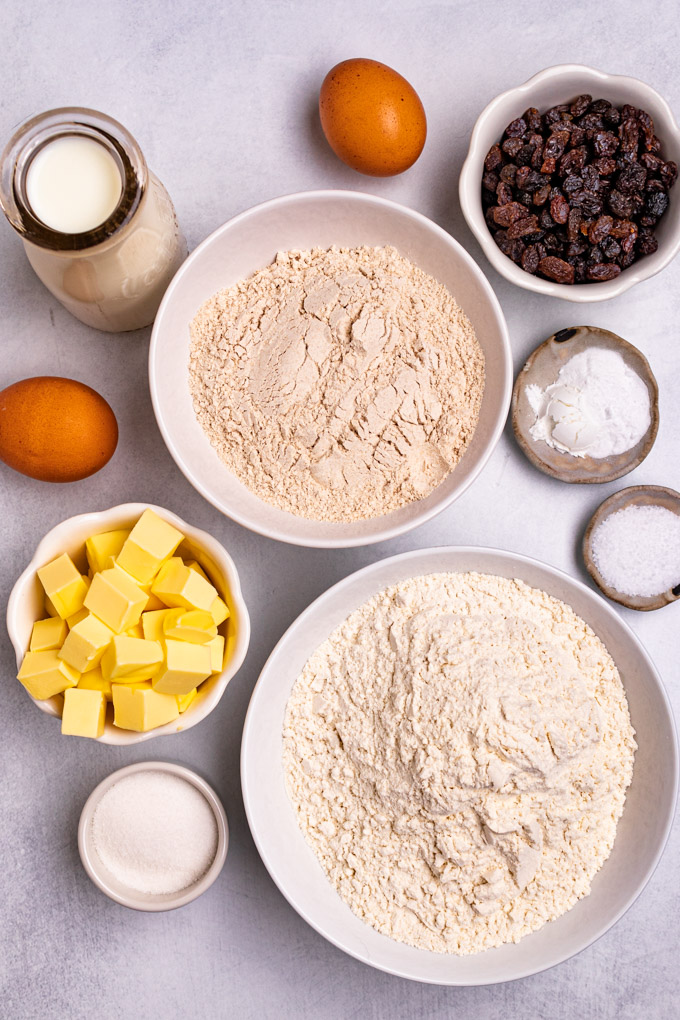
Ingredients for Irish scones
As always, the full list of ingredients, along with their measurements are listed in the recipe card below. Let’s discuss them here first.
- all-purpose unbleached flour – all purpose flour keeps the scones light and fluffy! Note: you can easily make these scones gluten free. See more info in the notes of the recipe card below!
- white whole wheat flour – I like the nuttiness, and heartiness the white whole wheat flour provides without being too dense. However, you can easily use all AP flour if you prefer.
- kosher salt – for bringing out the flavors.
- baking soda – our leavening agent that provides lift in the scones.
- baking powder – Another leavening agent. Baking powder is great because it also provides a little acid that reacts with the baking soda.
- granulated sugar – just a touch to add a hint of sweetness to the scones. Honestly, the sugar is what makes scones scones, and not a savory biscuit – so don’t skip.
- unsalted butter – cold butter helps to create a flaky, tender scone. Plus it adds a great flavor!
- raisins – raisins are optional. But, I love how they add a pop of sweetness.
- milk – the main source of liquid in our scones.
- egg – the egg provides binding and and structure to the scone.
Options for serving
- salted butter – for spreading onto the scones. I highly recommend using Irish butter, if you can. Kerrygold is my favorite and is easy to find in American grocery stories.
- Jam, or fruit preserves – you can use any flavor of jam you like. We enjoyed raspberry, strawberry, and blueberry jams.
- optional: whipped cream – It can be common to also serve Irish scones with whipped cream along with the butter and jam. I never had scones this way when I was in Ireland so I just stuck with the butter and jam, but if you want whipped cream, be sure to check out my whipped cream recipe!
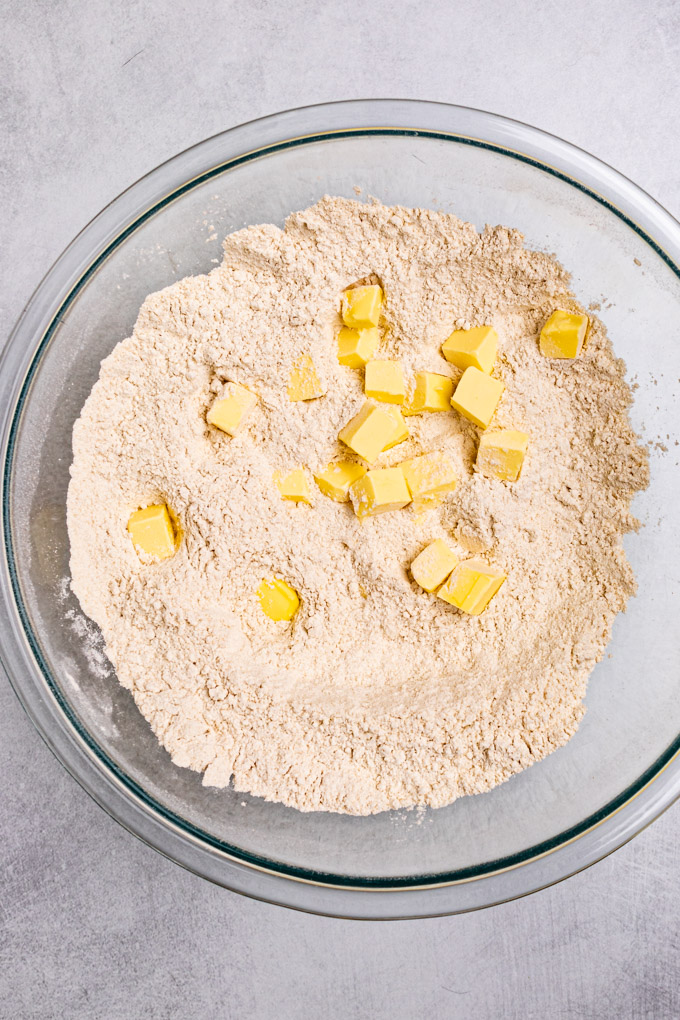
How to make Irish Scones
Of course, more detailed directions are in the recipe card below – let’s give you a preview here.
- prepare – chill your cubed butter and preheat your oven.
- mix together dry ingredients
- cut the butter into the flour
- add the raisins (if using)
- Add the wet ingredients – and mix the dough together.
- Roll out the dough.
- Cut out the scones.
- Brush the scones with egg wash.
- Bake the scones
- Cool the scones.
- Serve – with the butter and jam!
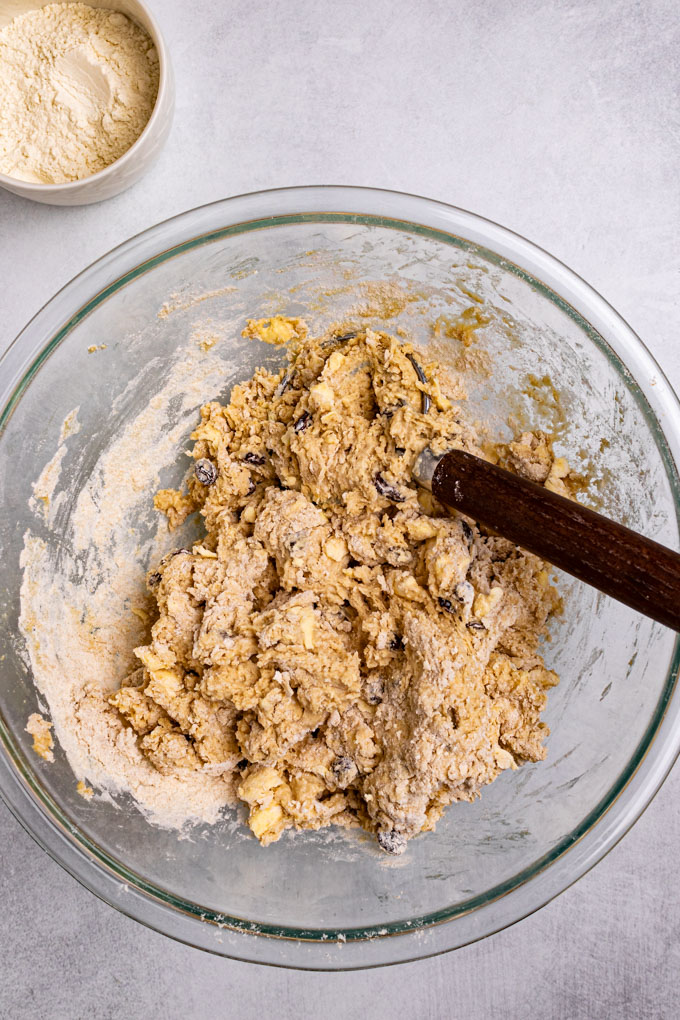
What is the difference between Irish scones and American scones?
Irish scones are just slightly sweet, and are more hearty and dense. They are meant to be served with a good amount of salted butter, and jam when eating. They are cut into round shapes, often with a scalloped edge. They often times have raisins, or currents baked into them.
American scones – from my experience – are a sweeter, more tender, but still dense pastry. They are made into various flavors, or have various fruits baked into them. They often times have some kind of glaze, or icing on top. They are usually cut into a triangle shape and are served on their own with out any extra toppings.
Are Irish scones the same as English or Scottish scones?
Irish, English, and Scottish scones are very similar to each other.
However, I am sure there are slight variances to each recipe that make them unique to their region. But, generally they are more alike each other than your American scone is.
If you want to learn more about Irish scones VS English, and Scottish scones, plus the history of scones – check out this post.
Is this Irish scone recipe traditional?
I did reference two Irish scone recipes that are written by Irish people when making my own version: Donal Skehan’s recipe for Traditional Irish Scones, and a recipe featured in Irish Food & Cooking cookbook!
However, I am an NOT Irish Grandma, so I can’t claim that this Irish scone recipe is authentic to the core. However, I think they are pretty stinking close to what I remember eating in pubs, and cafes while I was living in Ireland. So, I think they are really good, and you should make them!
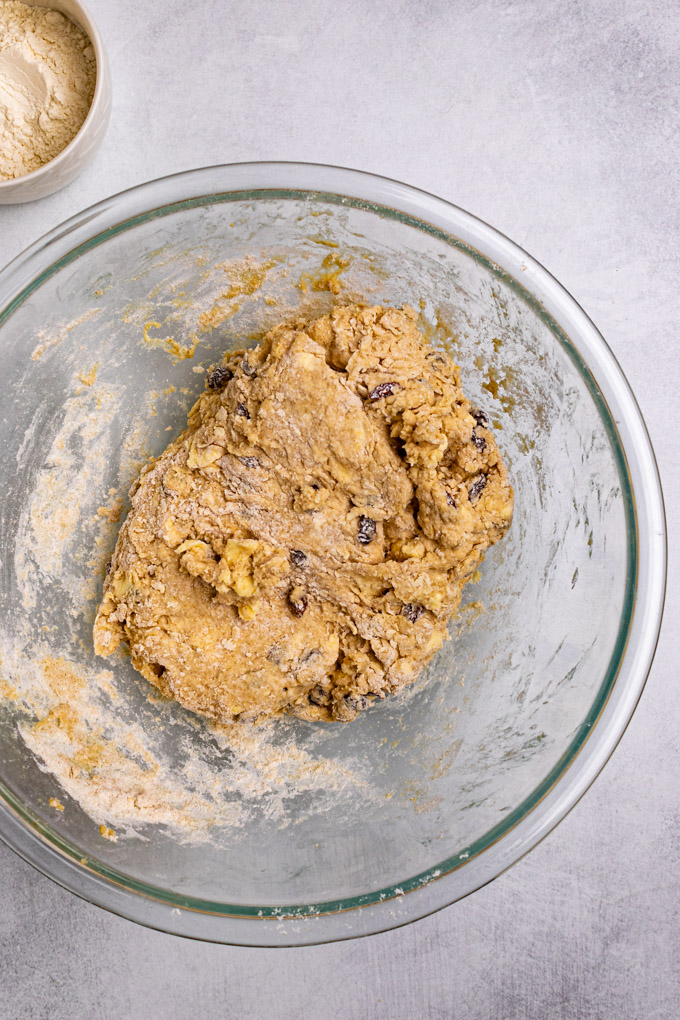
How is an Irish scone served?
Irish scones are usually split in half and spread with plenty of salted Irish butter. I recommend Kerrygold! And, your favorite jam/fruit preserves – we enjoyed raspberry, blueberry, and strawberry, but any flavor will be great.
Irish scones are often served for breakfast alongside a cup of hot tea. Or, for afternoon tea time, as a snack.
I love that about Ireland. Tea takes priority over coffee there!
Tea lovers rejoice!!!
I have read that it is also common to spread a little fresh, homemade whipped cream on your scones along with the butter and jam. If you want to give that a try, be sure to check out my whipped cream recipe!
Can I make this Irish scones recipe gluten free?
Yes!
I tested this recipe using Bob’s Red Mill Gluten free 1 to 1 Baking flour and it worked really well.
The flavor was just as delicious as the non-gluten-free ones. They were dense on the inside, and crunchy on the outside.
My parents who have to eat gluten free got to try them, and they were in love!
However, I will say that the texture of the gluten free scones were a little more crumbly than the non-gluten free scones were, but not overly so. That was the only drawback.
How long do Irish scones last?
They last for up to 3 days.
However, they are at their best on day one.

Equipment I used to make Irish scones
(Affiliate links)
- Parchment paper sheets – Parchment paper is essential to prevent the scones from sticking. These sheets make it super easy – no cutting required!
- Large rimmed baking sheet – USA pan come through every time. You will need two of them.
- Kitchen scale – I recommend using a kitchen scale to weigh your flour ingredients for the most accurate measurement.
- Danish dough whisk – I just got myself one of these, and it makes mixing together thick doughs like this one so much easier. Highly recommend!
- Liquid measuring cup – A liquid measuring cup is useful for measuring out that milk, and whisking the egg into the milk.
- Rolling pin – A rolling pin is necessary for rolling the dough out to the right thickness. I love my French style rolling pin.
- Pastry cutters – I like this set because you can choose either the scalloped side, or the plain, straight edge side for cutting out your scones. A scalloped edge is traditional to the Irish scone.
- Pastry Brush – is helpful for brushing on that egg wash so they scones get all golden and shiny.
- Cooling rack – to help cool the scones down quicker.
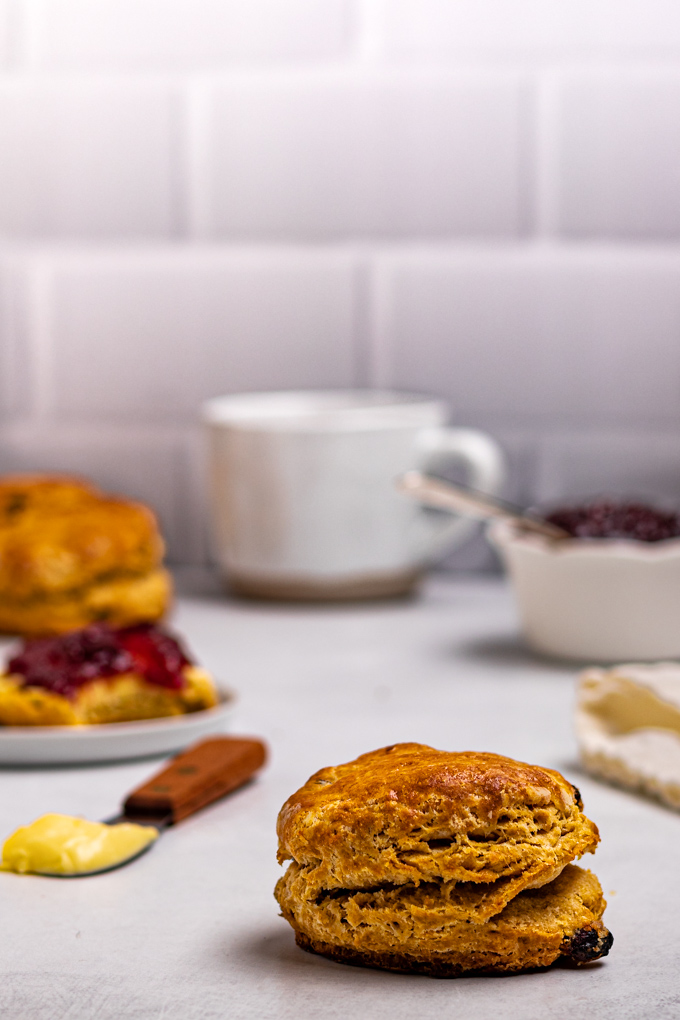
Reasons you will love Irish scones
- They’re a great way to celebrate St. Patrick’s Day!
- They’re hearty,
- flaky,
- buttery,
- and slightly sweet.
- They’re amazing served with butter, jam,
- and alongside tea.
- They’re easy to make:
- 1 bowl,
- 10 ingredients,
- and 37 minutes.
- They can easily be made gluten free.
- They’re perfect for a snack,
- or breakfast!
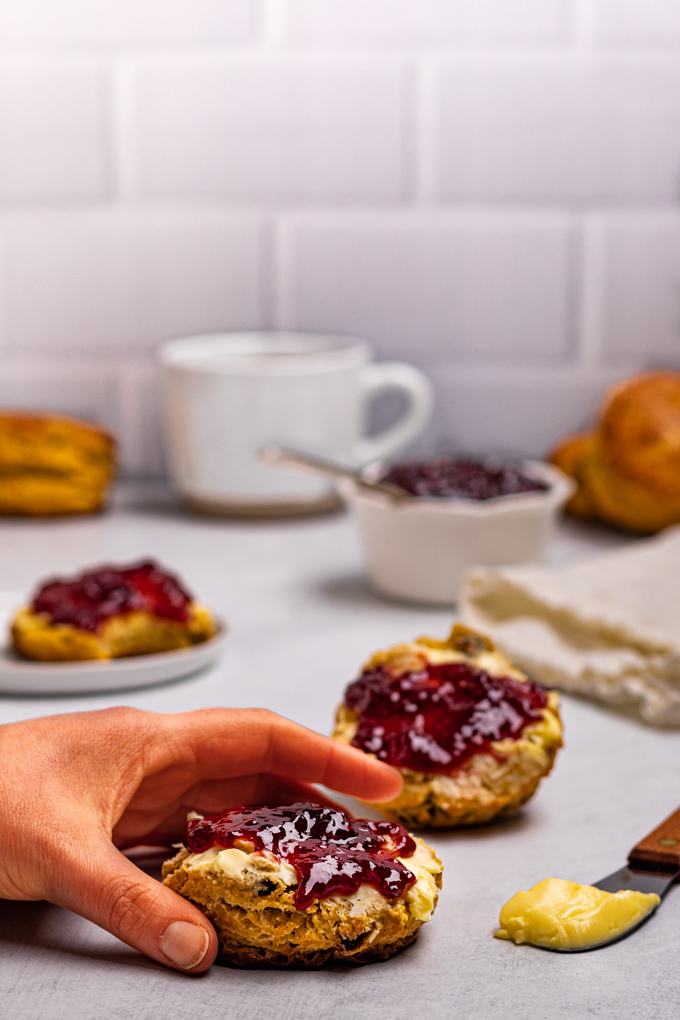
More Irish inspired recipes for St. Patrick’s Day!
- Irish Shepherd’s Pie
- Irish Champ (mashed potatoes with green onions)
- Irish Tea Bread (AKA Barmbrack)
- traditional Irish stew (with beef or lamb)
- Easy Irish Coffee
- Irish brown soda bread

Did you make this recipe?!
Tell me how it went. Leave a comment below, along with a star rating ⭐⭐⭐⭐⭐. The rating helps my recipe to rank higher in google, which helps my business to thrive! I appreciate it, thanks friends!
Print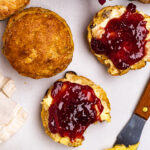
Irish Scones (Gluten Free Option)
- Prep Time: 15 mins
- Cook Time: 22 mins
- Total Time: 37 minutes
- Yield: 9 to 10 1x
- Category: baking, breakfast, snack, side
- Method: baking
- Cuisine: vegetarian, gluten free
- Diet: Vegetarian
Description
Irish scones are easy to make, and even easier to eat. Spread them with plenty of Irish butter and jam, and serve them with hot tea for the ultimate Irish experience.
Ingredients
Dry Ingredients
- 2 1/2 cups (300 grams) all purpose unbleached flour
- 1 1/2 cups (170 grams) white whole wheat flour (see notes)
- 1 1/2 teaspoon kosher salt
- 1 teaspoon baking soda
- 1 teaspoon baking powder
- 3 tablespoons granulated sugar
- 1/2 cup unsalted butter, cut into cubes – chilled (see notes)
- optional: 1/2 cup raisins, or currents (see notes)
Wet ingredients
- 1 1/4 cup milk (I used skim milk, you can use any kind you like)
- 1 large egg
Egg Wash
- 1 egg yolk
- 3 tablespoons milk
Options for serving
- Room temp salted butter
- Jam, or fruit preserves of choice
- optional: homemade whipped cream
Instructions
- Prepare – Cube the 1/2 cup butter, and place it back in the fridge while you prepare everything else. Note: if your kitchen happens to be on the warmer side, I suggest putting the butter in the freezer. Preheat your oven to 425 degrees farenheit. Line two medium baking pans with parchment paper – set aside.
- Mix together the dry ingredients – To a large mixing bowl add the all purpose flour, and white whole wheat flour, along with the kosher salt, baking soda, baking powder, and granulated sugar and stir to combine.
- Cut the butter into the flour – Add the cold cubes of butter to the flour mixture, gently toss them into the flour so they are nice and coated. Use your clean fingers to press the butter into the flour, working through each piece of butter until they resemble the size of chickpeas. Or, you can use a pastry cutter, if you prefer. Create a well in the middle of the bowl.
- Add the raisins (if using) – At this point, toss the raisins into the flour mixture, if using.
- Add the wet ingredients – Add the egg to the liquid measuring cup with the milk in it. Whisk until very well combined. Pour the liquid into the well of the dry ingredients. Use a rubber spatula, or a Danish dough whisk (highly recommend) to mix everything together until a shaggy dough forms. knead the dough a few times with the palm of your hand.
- Roll out the dough – Turn the dough out onto a clean, floured work surface. Lightly flour your rolling pin. Roll the dough out one time, then fold in half, roll out a two times, then fold in half again, and roll out the dough into an even 1 inch thickness. The folding process helps the dough to come together, and to make the scones extra flaky.
- Cut out the scones – Flour a 2 1/2 to 3 inch circle pastry cutter, and use it to cut out as many scones as you can. You should get about 4 scones. Note: a scalloped edge is very common with Irish scones, however, a round edge works fine too. Transfer each scone to the prepared baking sheet. After the first 4 scones are cut out, you can re-roll the dough a little and get about 4 to 5 more scones. Keep in mind, these re-rolled scones are never as good as the first ones, but they are still worth baking.
- Brush the scones with egg wash – Arrange the scones on the two baking sheets, I put 5 on each baking sheet. They won’t spread a lot, but allowing more air to circulate between them helps with browning. In the same liquid measuring cup that was originally used to measure out the milk, add the 1 egg yolk, and the 3 tablespoons of milk – whisk to combine well. Use a pastry brush to generously brush the tops of each scone – avoiding the sides of the scone.
- Bake the scones – Bake the scones in the preheated oven for 15 to 22 minutes, or until they are golden brown on the tops and bottoms. They should also seem dry to the touch. Note: I do recommend baking each tray of scones one at a time, they brown better. However, if you want to bake them at the same time, then swap the trays half way through the baking time. You may also need to increase the baking time just a little bit.
- Cool the scones – Allow the scones to cool on the baking pan, on top of a cooling rack for 10 minutes. After 10 minutes you can transfer them to the cooling rack to finish cooling completely.
- Serve – You can serve the scones slightly warm, after about 10 to 15 minutes of cooling time – very good. Or, you can wait until they are room temp to serve them, also very good. Serve with plenty of salted Irish butter, and your favorite flavors of jam/fruit preserves for spreading on top. Scones tend to be on the dryer side, and are meant to be a vehicle for lots of butter and jam. So good! They are also great served with tea, or coffee!
- Store – Although, the scones are at their best the first day, they are still very good for up to 3 days when stored correctly. Store the cooled scones in an air tight container that is lined with paper towels. You can stack the scones, just make sure to place a layer of paper towel between to absorb any moisture. Store at room temp.
Notes
white whole wheat flour – I like the nutty flavor, and hearty texture the white whole wheat flour provides. You can easily swap it for more all purpose flour if you prefer.
unsalted butter – I highly recommend using an Irish butter, if you can find it. Kerrygold is my favorite. It has a higher butterfat content than American butter, which will make the scones taste extra good. The next best option would be another European style butter, which will contain more fat than American butter.
raisins vs currents – In Ireland currents are these tart, plump delicious little berries that I enjoyed in so many things while I was living there. However, I can’t find the same type of currents in America – they are pretty flavorless. Raisins are the next best option, IMO. It is pretty traditional to use raisins or currents in Irish scones. However, you can easily leave them out if you prefer.
Whipped cream, for serving – from my research, I found that it is common to serve Irish scones with whipped cream along with the butter and jam. I never had scones this way in Ireland, so I stuck with the butter and jam for my serving options. However, if you want whipped cream, be sure to check out my whipped cream recipe!
Gluten free option – Simply swap both the white whole wheat flour and the all purpose flour with an all purpose gluten free flour mix. I used Bob’s Red Mill Gluten Free 1 to 1 Baking flour, and it worked great. I did have to add a little bit more milk to the dough because it seemed dry, but other than that making the gluten free scones was the same process as making the non-gluten free versions. And, the gluten free Irish scones turned out great. They were a little bit more crumbly than the regular scones, but overall, they had a great flavor and texture. My gluten free eating parents got to try them, and they loved them!
This recipe was adapted from Irish Food & Cooking: Traditional Irish Cuisine with over 150 delicious step-by-step recipes from the Emerald Isle by: Biddy White Lennon and Georgina Campbell. I have been using this cookbook for years, I love it! It is also adapted from Donal Skehan’s recipe for Traditional Irish scones – another great source for Irish food!!!





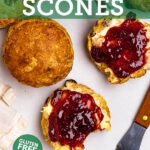

Wonderful!
Thank you!
“I love that this recipe is gluten-free. It’s hard to find good gluten-free recipes, but this one is a winner.”
I am so glad to hear you enjoyed the recipe! Thanks for the kind review. 🙂
Can you convert your recipe to use an airfrier
Hi, I am sure you can make the scones in the air fryer, but I don’t have an air fryer myself, so I am not able figure out exactly what that conversion might be. I did find this recipe for blueberry air fryer scones: https://airfryingfoodie.com/air-fryer-blueberry-scones/ – you could possibly use the temperature and cooking time from that recipe with my scone recipe. Depending on your air fryer, you might not be able to fit all of the scones in the air fryer at one time.
Hope this helps. Let me know how it goes. 🙂